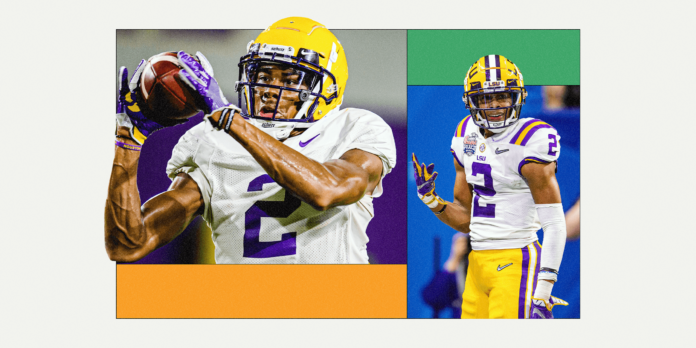Once upon a time, in a galaxy not so far away, there was this talented receiver who caught 111 passes for 1,540 yards and 18 touchdowns in the most difficult conference in college football. But here’s the deal, people had questions: Is he too small? Too slow? Not physical enough? And he played primarily as a slot receiver in a class filled with players who played more outside. Talk about a triple whammy!
So, on draft night, all eyes were on him, wondering where he’ll end up. And then, other players got selected before him! Henry Ruggs, Jerry Jeudy, CeeDee Lamb and Jalen Reagor all got picked before him. Yeesh, talk about a classic overshadowing situation.
Fast forward to today, and this talented receiver has become a superstar who has achieved more in his first three seasons than any other receiver in NFL history. Marucci, the guy who believed in him when no one else did, is now looking at him with so much pride it’s like he’s a second father. “I always thought you were crazy,” said his NFL friend. “I don’t know how you knew.” Marucci likes to say he “just had a sense,” but the truth? It was backed by cutting-edge data that proved the receiver’s uniqueness.
For too long, people had a one-track mind when it came to athletes: they focused on traditional athletic tests like the 40-yard dash, vertical leap, and the bench press. But Marucci wanted to take things one step further. He wanted to quantify what we can’t see. He was particularly interested in two kinds of players: can’t-miss prospects who were athletic but failed to excel on the field and under-the-radar talents who didn’t have elite size, strength or speed but still managed to excel.
So, Marucci did his homework, and in the 2010s, he worked on quantifying subjective beliefs about players’ character traits and cognitive abilities into objective insight. Enter Brandon Ally and Scott Wylie, who had a related idea. Both former college athletes, they had worked with Alzheimer’s and Parkinson’s patients, studying how humans perceive and process information. So, they wondered: what if they could apply that knowledge to sports? Enter S2 Cognition, a company that worked on testing a player’s ability to process information on the field.
Marucci soon jumped on board, and he started testing everyone, and to his shock, good corners and receivers performed better than most. After rummaging through pages and pages of data, he realized that players who had to quickly make decisions and improvise when things went awry performed better in the cognitive tests. It’s kind of like taking a surprise exam – if you can ace that, you can go ahead and sign up for Mensa!
Apart from cognitive abilities, Marucci also believed that a player’s vision is crucial to their performance, and he was willing to try anything to prove it. So, he rigged some of the best receivers in college football with a pair of $14,000 glasses that recorded information in real-time, such as how their pupils expanded and their eyes sequenced as they tracked down a pass. It was no fashion statement, but an ultimate experiment that would prove or disprove his hypothesis.
Marucci adored ocular dominance, since he’s the founder of Marucci Sports, which produces bats used by Bryce Harper, Anthony Rizzo, and others. He understood how important it was to obtain data to find out how elite athletes visualized the world. This led him to Tobii Pro, which develops hardware for eye tracking. With Tobii Pro technology, Marucci and Mike Mann, a former volleyball player and volunteer assistant at the University of Florida, recorded hundreds of thousands of data points on 15 pass catchers. Groovy!
This helped Mann identify which receivers would be more productive than others on different routes from certain locations based on their ocular strengths. The information helped some receivers eliminate drops — tight end Thaddeus Moss, for example, did not register a single drop for LSU in 2019. Whoop whoop!
Marucci believes that if a guy struggles catching the ball, you can uncover the “why” by tracking them. Similarly, if a guy always seems to make the correct play, Marucci thinks it’s worth pursuing information that explains his abilities. Why not? It’s always important to dig deeper – it’s like ordering dark chocolate and getting a free sample of white chocolate.
In conclusion, Marucci saw it all coming because he believed in his data. He marveled at the receiver’s willingness to seek out training from elite coaches and spent time honing his craft. All those elements, combined with what Marucci knew was inside the receiver, went a long way in helping him become one of the best in the game. The result? That one catch in Buffalo on fourth-and-18, where he left the ground, navigated visual chaos, and contorted his body to catch the pass. And all the play-by-play announcer could say was, “How?” Well, now we know the answer.
Serious News: nytimes

